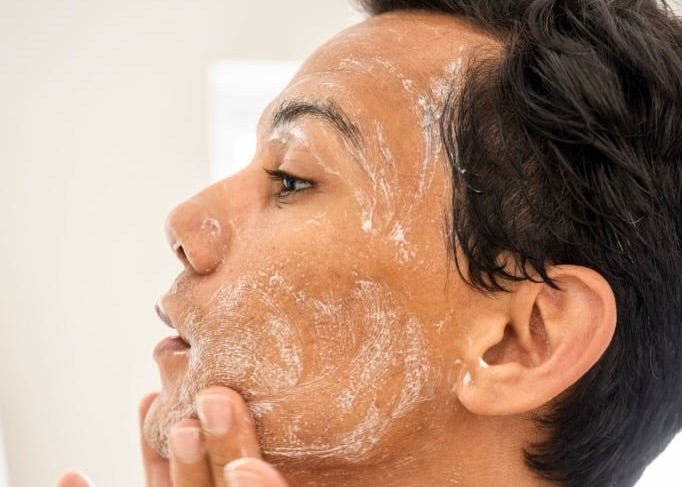
AHA vs. BHA: Understanding the Differences
Are you curious about the differences between AHA and BHA? These two popular skincare ingredients have been getting a lot of attention lately, and for good reason. In this article, we will demystify the world of exfoliants and explore what sets AHA and BHA apart.
Introduction to AHA and BHA
Before we compare AHA and BHA, let's understand what they are individually.
Alpha Hydroxy Acids (AHAs) and Beta Hydroxy Acids (BHAs) are two types of chemical exfoliants that are commonly used in skincare products. These acids work by gently dissolving the bonds between dead skin cells, helping to reveal smoother and brighter skin underneath.
What is AHA?
AHA stands for Alpha Hydroxy Acid. It is a group of natural acids derived from fruits and milk. Common AHAs include glycolic acid (derived from sugar cane), lactic acid (from milk), and citric acid (from citrus fruits).
AHAs are known for their ability to exfoliate the skin's surface, helping to improve texture and tone. They are water-soluble acids that work well for individuals with dry or sun-damaged skin. AHAs can also help in reducing the appearance of fine lines and wrinkles over time.
What is BHA?
BHA, on the other hand, stands for Beta Hydroxy Acid. The most commonly used BHA is salicylic acid. Unlike AHAs, which are water-soluble, salicylic acid is oil-soluble, making it ideal for penetrating deep into the pores.
BHAs are particularly beneficial for individuals with oily or acne-prone skin, as they can penetrate oil glands and help to unclog pores. Salicylic acid, a type of BHA, is known for its anti-inflammatory and antibacterial properties, making it an excellent choice for treating acne and blackheads.
The Science Behind AHA and BHA
Before we dive into the differences, let's explore how AHA and BHA work.
Alpha Hydroxy Acids (AHAs) and Beta Hydroxy Acids (BHAs) are two types of chemical exfoliants commonly used in skincare products. These ingredients are known for their ability to improve skin texture and appearance by promoting exfoliation.
How AHA Works
AHAs work by gently exfoliating the surface of the skin. They dissolve the bonds between dead skin cells, allowing them to slough off more easily. This process reveals fresher, smoother skin underneath. In addition to exfoliation, AHAs also have hydrating properties, helping to improve skin moisture levels and overall complexion.
One of the most common AHAs is glycolic acid, which is derived from sugar cane. Glycolic acid is known for its small molecular size, which allows it to penetrate the skin effectively. This makes it a popular choice for addressing concerns such as fine lines, dullness, and uneven skin tone.
How BHA Works
Beta Hydroxy Acids (BHAs), like salicylic acid, are oil-soluble, which means they can penetrate the pores deeply. They work by exfoliating the inside of the pores, effectively unclogging them. This makes BHA especially beneficial for those struggling with acne and blackheads. In addition to exfoliation, salicylic acid also has anti-inflammatory properties, making it a great option for individuals with acne-prone or sensitive skin.
Salicylic acid is derived from willow bark and is known for its ability to reduce excess oil production and calm redness and irritation. By targeting clogged pores and inflammation, salicylic acid can help improve the overall clarity and texture of the skin.
Comparing AHA and BHA
Now, let's delve deeper into the fascinating world of skincare by exploring the similarities and differences between AHA and BHA.
When it comes to skincare, understanding the nuances between different types of exfoliants can make a world of difference in achieving radiant and healthy skin. AHA (Alpha Hydroxy Acid) and BHA (Beta Hydroxy Acid) are two powerhouse ingredients that offer remarkable benefits for your skin.
Similarities Between AHA and BHA
Both AHA and BHA exfoliants offer incredible benefits for the skin. Here are some key similarities that make them stand out in the realm of skincare:
- Both exfoliants work diligently to slough off dead skin cells, unveiling a smoother and more youthful complexion.
- They share the ability to enhance the texture and tone of the skin, leaving it looking rejuvenated and radiant.
- Whether it's fine lines, wrinkles, or dullness, both AHA and BHA can help address various skin concerns, promoting a healthier overall appearance.
While the similarities between AHA and BHA are impressive, it's equally important to recognize the distinct characteristics that set them apart and cater to different skin needs.
Differences Between AHA and BHA
While AHA and BHA share common ground in their exfoliating prowess, they each bring unique qualities to the table. Here's a closer look at the disparities between these two skincare heroes:
- AHA is water-soluble, making it ideal for addressing surface-level skin concerns, while BHA, being oil-soluble, has the ability to penetrate deep into the pores, making it effective for combating issues like acne and blackheads.
- While AHAs primarily work on the skin's surface, providing gentle exfoliation and brightening effects, BHAs have the remarkable ability to unclog pores and reduce inflammation, making them a go-to choice for those with oily or acne-prone skin.
- When it comes to choosing between AHA and BHA, consider your skin type and specific concerns. AHA may be more suitable for individuals with dry or sun-damaged skin, seeking to improve overall texture and tone, while BHA could be the preferred option for those dealing with acne, excess oil production, or persistent blackheads.
Benefits of AHA and BHA
Now that we have discussed the differences, let's explore the benefits of using AHA and BHA in your skincare routine.
When it comes to AHAs, the advantages are plentiful. These exfoliating acids work wonders for your skin in various ways. Firstly, AHAs help to gently slough off dead skin cells, promoting a brighter and more youthful complexion. By removing this layer of dull, dead cells, AHAs reveal the fresh, radiant skin underneath. Additionally, AHAs are known for their ability to target fine lines, wrinkles, and sun damage, making them a popular choice for those looking to combat signs of aging. Another key benefit of AHAs is their knack for enhancing the absorption of other skincare products. By exfoliating the skin's surface, AHAs pave the way for better penetration of serums, moisturizers, and treatments, allowing them to work more effectively.
On the flip side, BHAs offer their own set of unique advantages that cater to specific skin concerns. BHAs, such as salicylic acid, are particularly effective in addressing acne, blackheads, and congested pores. These oil-soluble acids can penetrate deep into the pores, dissolving excess sebum and debris that can lead to breakouts. Furthermore, BHAs boast anti-inflammatory properties, which can help soothe redness and irritation, making them a great option for those with sensitive or acne-prone skin. Another standout benefit of BHAs is their ability to regulate oil production. By balancing sebum levels, BHAs can be a game-changer for individuals with oily or combination skin, helping to mattify shine and minimize the appearance of enlarged pores.
Potential Side Effects of AHA and BHA
While AHA and BHA offer numerous benefits, it's important to be aware of potential side effects.
Risks Associated with AHA
AHAs can increase the skin's sensitivity to the sun, so it's crucial to wear sunscreen daily. They may also cause slight tingling or redness, especially for those with sensitive skin.
Another potential side effect of AHA is known as "purging," where the skin may temporarily experience an increase in breakouts as it adjusts to the exfoliation process. This is a normal reaction and should subside after a few weeks of consistent use.
Risks Associated with BHA
Sensitivity to BHA is rare, but it is possible. If you experience any redness, dryness, or irritation, it's best to discontinue use. As with AHAs, sunscreen is essential when using BHA.
It's worth noting that BHA, also known as salicylic acid, is particularly beneficial for those with oily or acne-prone skin due to its ability to penetrate oil-filled pores and exfoliate inside the follicle.
Now that you understand the differences between AHA and BHA, you can make an informed decision about which exfoliant is best for you. Remember, everyone's skin is unique, so it may take some trial and error to find the perfect fit. Whether you choose AHA, BHA, or a combination of both, incorporating these effective exfoliants into your skincare routine can help you achieve healthier, more radiant skin.
















